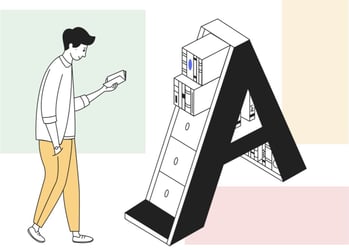Buyer personas are all the rage right now in marketing - they're essential for boosting your website's lead generation. Toby has covered how to write a persona on this site.
While I agree they can be extremely useful for planning your marketing campaigns, social media strategy and tone of voice guidelines, when it comes to writing intoxicating content, you need to dig a little deeper.
What are personas?
Let's start with a cliche: Google defines 'persona' as,
The aspect of someone's character that is presented to or perceived by others.
Sometimes this can be an amplified version of something very natural and recognisable from someone's personality. And sometimes it can be such an exaggerated version of a natural aspect that it almost disguises the original character it has originated from.
Joe Bunting describes it as the difference between Joni Mitchell and Lady Gaga.
To be bare or brash?
The former persona, 'the Mitchell' as I'll call it, requires you to expose, very honestly, your weaknesses and the core of what makes you tick. It means choosing aspects of your character that people can relate to on an emotional and empathetic level, which basically means exposing your wounds.
The latter, 'the Gaga', is no less honest, despite appearances to the contrary. For this type of persona to be effective it has to be based on something that is natural to you, but something many people might consider outrageous or contraversial.
You then have to take that aspect and wear it with total confidence and unwavering honesty: you need some guts to pull this off.
Both types of persona are equally useful in writing because both expose vulnerability.
The value of vulnerability
Vulnerability is key to good writing and to effective marketing because without vulnerability, you have no connection.
Brené Brown, a research professor who has spent the last decade studying vulnerability, courage, worthiness and shame, explains this idea better than I ever could in her TedTalk.
To put it (very) simply, translated into copywriting terms, Brown's argument means that:
- Even in a sales brief, or an online product description, you need to be able to accept and acknowledge your readers' vulnerabilities, reassure them that they are still worthy and capable, and be willing to accept your own (or your business' own) vulnerabilities and retain your sense of worthiness if you want to develop a meaningful and constructive connection.
Relating to your reader's persona
Creating, or rather unearthing your reader persona for a given project can certainly start with the outline of a buyer persona. Kelly Kautz writes on Copyblogger,
Instead of addressing a crowd, write as if you’re having a conversation with your favorite reader. If you’re not sure who that is, make up an imaginary friend.
She suggests, similarly to Toby, that you decide on their demographic information (although goodness knows why marital status is relevant, personally I'd leave that one out), challenges and pain points, influences, a typical work day and of course their goals.
You want to base this information on real buyers or readers you already have, it's not just an exercise in imagination. As Toby writes,
Crucially you want to tell a story, which means a focus on behaviours rather than just a list of speculative facts...it takes time and effort to properly research and flesh out buyer personas.
Done properly, a buyer persona can give you a great foundation for a business reader persona, but to write copy that will connect, you have to dig a little deeper, and get a little more intimate.
Get beneath your reader's skin
We all wear a metaphorical mask to the office; we have our own buyer (or writer, or lawyer etc) persona, but when we read we have no reason to restrict ourselves to just that side of us, even if we are in the office while we are reading.
How someone reacts is based on aspects of their personality that they may not reveal at work and that therefore may not enter into a buyer persona. And that is the key difference between a buyer and a reader persona.
To achieve truly relatable, engaging and intoxicating content, you have to see beneath your buyer persona and start to think about aspects of their private, non-work personality that will inform how they connect with content.
Think about what uncertainties, vulnerabilities and worthiness would be included in their out-of-office persona, for example:
- Who in their life do they listen to outside of work?
- What sort of purchasing decisions do they make for themselves - ethical, trendy, local, cheap? What are their personal priorities?
- What sort of mistakes might they be frightened of repeating? Especially at work - have they made bad decisions before?
- Who in your life, that you know personally and know well, is most like who you are writing to? What can you incorporate from their identity?
- What barriers do they put up? Brené Brown says we try to escape vulnerability and shame in different ways like numbing, seeking perfectionism, apportioning blame etc. We all do it, but how would your reader? And how can you respect and engage with that to try and get past it?
And who, exactly, are you?
Since personas can bring out the most intense or relatable aspects of a personality, it is also worth taking some time to think about your own writer persona.
This means leaning in to your own shortcomings or imperfections, and knowing you are still worthy of attention and love (including a reader's love of what you have to say and how you say it).
This might seem daunting, but as Maria Bustillos argues, a writer can never really escape vulnerability. She writes on the New Yorker blog,
Writers are generally fated to commit the truest parts of themselves to the page, whether they choose to own their work in public or not. That is the ultimate vulnerability, and it is inescapable.
Or, what are you?
In business writing, of course, you can often be writing on behalf of a company or even a particular division or group of offerings. In that case, developing your writer persona for that project can mean taking a tone of voice document or brand guidelines (a commercial persona as it were) and thinking about how to integrate that with your own writer persona.
This might sound a bit abstract, so here's an example.
Turbine, Articulate's sister company, is an online HR application. It is aimed at small to medium enterprises. It does some things extremely well, but does not pretend to do everything. Turbine has more of a 'Mitchell' persona and the way we write on our blog reflects that:
This is what we’re trying to do with Turbine. It’s an affordable off-the-shelf way to do routine admin chores that works well for the majority of businesses.
My question for you is: are you letting ‘perfect’ get in the way of ‘good enough’? Stop wasting time and money seeking the perfect solution and upgrade to almost-perfect.
The writer(s) for Threadless, on the other had, take its commitment to promoting unknown artists and its unapologetic support of the weird and wacky to create more of a 'Gaga' writer persona:
We started printing on tees and then we realized tons of products make great canvases. We seek out these canvases, so you can continue to make and pick the best art. The weird art. The geeky art. The beautiful art. And every time you buy from us, you're supporting great art too.
In both examples, the writer has followed what Brené Brown advocates: they have created a hybrid persona that displays courage by telling the story of who (or what) the product or brand is whole heatedly and embraces its imperfections. At the same time, the persona retains its worthiness: its imperfections are no reason not to read and connect with the content.
Brands are not people
Of course they're not. But you can borrow from the more intimate idea of reader and writer personas in the non-commercial world to develop constructed personas that amalgamate real customers with ideal buyers, and your personal writer persona with a company or product persona.
And it's with those creations that you can then write more powerful and intoxicating content, which ultimately builds better connections between everyone.





